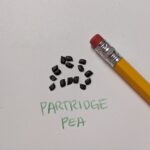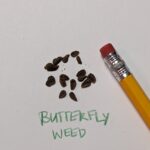Instructions for Planting
With a few steps, you will be on your way to creating a blooming native habitat at home.
These seed packets were packed (with love) by FOLAR staff and volunteers and funded by the John Randoph Foundation Tri Cities Environmental Endowment.
When to plant:
In winter, early spring, or in the cool of fall well before the first frost. That first freeze might kill a baby plant that hasn’t had a bit of time to establish roots to over-winter with for next year. Planting in late spring or the summer may be too hot and dry for a young seedling to survive.
Some seeds require stratification (a cool damp period, i.e. a winter) before they can germinate (start to grow). The plant-by-plant list below explains which plants you can expect to grow as soon as you place them in a moist, sunny location, and the ones that require winter stratification before germinating the next spring.
How to plant:
Choose a place to scatter your seeds. A sunny area of about 5ft by 10ft will work. The seeds in this packet are blooming perennials (plants that will come back for multiple years) that enjoy plenty of sun, but may handle some shade. Remove existing vegetation by pulling it up thoroughly (the plant-it-now, fast option) and/or covering it thoroughly with cardboard, mulch and fallen leaves (to shade out existing grass and plant seeds next year). This is your garden bed!
No need for fertilization. These plants are native and should be able to make do with the soil quality that you have. Fertilization may encourage non-native weeds to invade the flower bed. Removing the plants that existed should have roughed up the soil enough- there is no need to dig holes for the seeds included. Scatter your seeds with enough space to give plants enough room to grow (two to six inches apart). A good method of doing this is mixing the seeds in with sand, and scattering it thinly over the area. Compress the soil lightly, with a roller or the back of a rake, so that the seeds have good contact with the soil around them. Keep the area moist until the plants have become established (no need to water in the winter). Plants are established when 4-8″ tall. Then feel free to let them do their thing! These plants will not need to be pampered.
There are more seeds in this packet than one might think! See the plant list below for estimated quantities of the teeny-tiny seeds. You may want to spread thinly or space out your plants once they start growing. If you choose to move your plants around, be sure to dig deep enough to get as much of the root as possible. Moving is easier on an established plant when the soil its roots are in is moved along with it. Always be sure to “water in” a plant after moving it from one place to another- a drink will help them re-establish!
Life Cycle:
Native plants can take a long time, sometimes years, to establish from seed. Perennials are long-lived, so they will become more successful as they get mature. Some of the seeds in this packet will show blooms in their first year, but others may need time to gain their footing before giving their colorful display. Keep an eye on your garden bed and use plant identification apps like PictureThis or iNaturalist to see what is popping up, and what you have to look forward to!













 Beebalm (Monarda fistulosa):
Beebalm (Monarda fistulosa): Black Eyed Susan (Rudbeckia hirta):
Black Eyed Susan (Rudbeckia hirta): Plains Coreopsis:
Plains Coreopsis: Partridge Pea (Chamaecrista fastciculata):
Partridge Pea (Chamaecrista fastciculata):
 Liatris Blazing Star (Liatris spicata):
Liatris Blazing Star (Liatris spicata):
